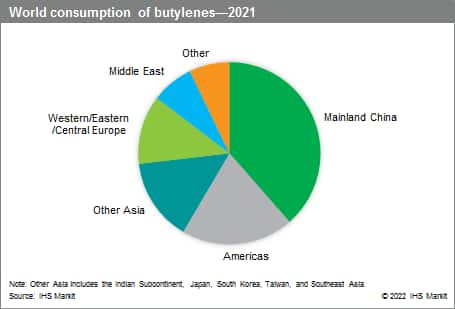Published June 2022
Butylenes, also referred to as butenes, are four-carbon mono-olefins that are produced in various hydrocarbon processes, principally catalytic cracking in refineries and steam cracking in olefins plants. These processes yield isomeric mixtures of butene-1, cis- and trans-butene-2, and isobutylene. Butylenes for chemical feedstock are diverted from streams with the appropriate isomer content. Both isomer and purity requirements for chemical production vary depending on the intended application. Derivatives of butylenes range from alkylates and methyl tertiary-butyl ether (MTBE)—where crude butylenes streams may be used—to butene-1 and highpurity isobutylene derivatives.
In 2021, the fuel market accounted for 80% of the total world consumption of butylenes, with chemical usage accounting for the remainder. The major fuel application is in the manufacture of gasoline blending components such as gasoline alkylates and methyl tertiary-butyl ether (MTBE) and ethyl tertiary-butyl ether (ETBE), which are used as octane improvers in fuel applications. Mainland China is by far the largest butylenes market globally.
The following pie chart shows world consumption of butylenes:

Overall, consumption of butylenes is forecast to increase moderately during 2021–26, with fuel uses still expected to drive the market in the near term.
For more detailed information, see the table of contents, shown below.
S&P Global’s Chemical Economics Handbook – Butylenes is the comprehensive and trusted guide for anyone seeking information on this industry. This latest report details global and regional information, including

Key benefits
S&P Global’s Chemical Economics Handbook – Butylenes has been compiled using primary interviews with key suppliers and organizations, and leading representatives from the industry in combination with S&P Global’s unparalleled access to upstream and downstream market intelligence and expert insights into industry dynamics, trade, and economics.
This report can help you
- Identify trends and driving forces influencing chemical markets
- Forecast and plan for future demand
- Understand the impact of competing materials
- Identify and evaluate potential customers and competitors
- Evaluate producers
- Track changing prices and trade movements
- Analyze the impact of feedstocks, regulations, and other factors on chemical profitability

















